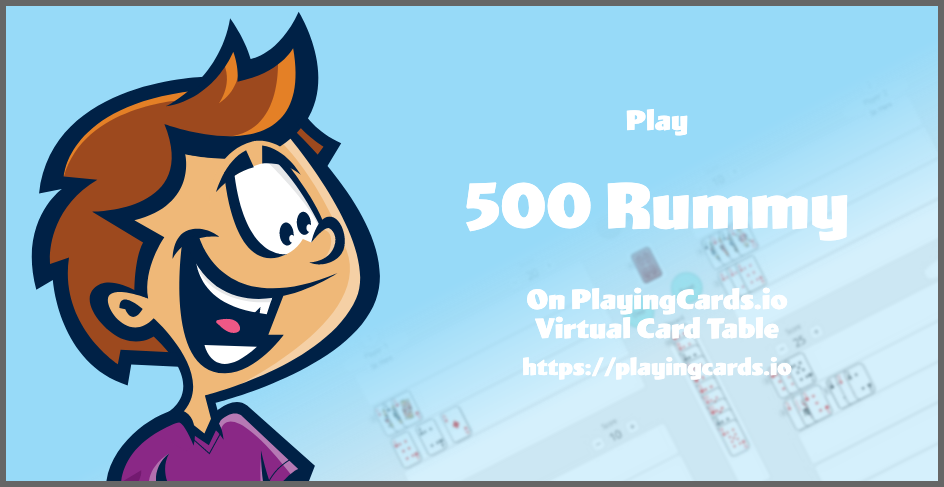500 Rummy on PlayingCards.io

A fast-paced Rummy variant where players compete to be the first to empty their hands and reach 500 points. Don't rack up a negative score, and watch out for people calling "Rummy!" on your turn! Often called 500 Rum, Rummy 500, or Pinochle Rummy.
Check out our Rummy infographic
Objective
- The ultimate goal of 500 Rum is to be the first player to reach a cumulative score of 500 across a series of hands.
- Points are earned by creating melds or laying off cards onto existing melds anywhere on the table.
- Points are lost for having cards in hand when another player goes out (empties their own hand).
Set Up
- Use one standard deck of 52 cards plus two Jokers for a group of 2, 3, or 4 players.
- Choose a dealer by drawing cards from the shuffled deck, with the highest being the winner. Re-shuffle the deck, then deal each player seven cards. (If only two players are playing, deal 13 instead of seven.)
- Take the top card from the deck and place it face-up to begin the discard pile.
- The person to the dealer's left goes first; play passes clockwise.
Playing the Game
- When a player's turn begins, they have the option of drawing the top card from the deck, the top card from the discard pile, or a card from lower down in the discard pile. If the player takes a lower card from the discard pile, they must immediately place that card in a valid meld, and they must also take all of the cards above that card in the discard pile.
- Next, a player may lay down new melds from their hand onto their side of the table, face-up. They may also lay off cards from their hand onto their own melds, or onto existing melds created by other players. If a card is added to another player's meld, the person playing the card must announce which meld they're adding it to, then place the card on their own side of the table. Note that once a card is played onto another meld, it may not be moved, nor be counted as part of a different meld.
- Melds come in two varieties: groups and sequences. A group is three or four cards of the same rank (eg. Jack of Spades, Jack of Hearts, Jack of Diamonds). A sequence is three or more consecutive cards of the same suit (eg. 6 of Hearts, 7 of Hearts, 8 of Hearts). Aces are either high or low, but not both at the same time in a single sequence. Jokers are wild.
- To end their turn, a player will discard a card from their hand face-up on top of the discard pile. If they only drew the top card from the discard pile, they must make sure to discard a different card.
- If a player discards a card that could have been added to a meld, or if they leave a card in the discard stack that could be added to a meld, any other player may call "Rummy!" before the next player draws. When they call Rummy, that player takes the discard pile down to the relevant card, continues to play new melds or lay off cards onto existing melds, and finally discards a card. Play then continues to the person to their left instead of reverting to the player whose turn was interrupted.
- Play continues clockwise until someone lays off their entire hand or the stock deck is exhausted, at which point scores are tallied.
Taking a Turn
- Draw a card from the draw pile, take the top card from the discard stack, or take multiple cards from the discard stack.
- Play new melds or lay off cards from your hand onto existing melds.
- Discard a card.
- Watch for opportunities to call "Rummy!" during other players' turns.
Scoring
- As soon as a player empties their hand, play stops and scores are tallied.
- Points are subtracted for each card in each player's hand, while points are added for each card in their melds. Use the chart below to determine value:
- Ace, Joker: 15 points each
- K, Q, J: 10 points each
- 2, 3, 4, 5, 6, 7, 8, 9, 10: face value
- Aces melded in a sequence with a 2 and 3 of the same suit: 1 point instead of 15
- Tally the scores for each player. If someone reaches at least 500 points, they are declared the winner.
- If no one reaches 500, keep the scores as they currently are, reshuffle all melds, hands, and cards in the discard pile, and begin another round.
Welcome!
PlayingCards.io is an online play space which allows you to play any tabletop or card game directly in your browser, multiplayer with your friends, for free. No app install is needed.
Create a room and share the room code to get started.